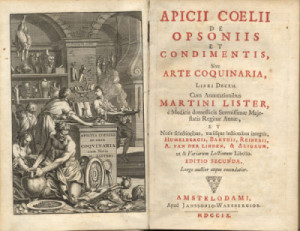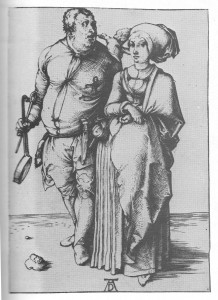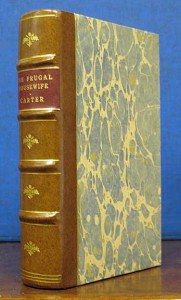Tavistock Books’ recent acquisitions contain a large focus on Cookery titles. Not only have we recently had in stock the cookbook with the 1st English Language recipe for tacos, but also The Cook’s Oracle, the first cookery book published out of Stockton, California (a more exciting purchase than you might think, which generated enthusiasm from around the country). The influx of interest in the food genre persuaded us to write this short, slightly perverse and tongue-in-cheek history of Cookery Books.
The Roman Gourmet

An error of 19th c. scholarship attributed the work API CAE to an “Apicius Coelius”, but modern scholarship shows that the name is almost certainly Marcus Gavius Apicius.
We can assume that the first person to ever cook something (let’s face it… most likely a woolly mammoth or something equally as strange) probably did it completely accidentally – perhaps by dropping their meat on an open flame and deciding to eat it anyway. Lo and behold! It’s so much better when it isn’t dripping blood on you! (Unless it’s steak tartar, which I highly doubt cave men had, but what do I know?) The first cookery book and collection of recipes known to man is a work falsely attributed to Marcus Gavius Apicius (falsely, as the surviving copy dates from the 4th or 5th century AD, and Apicius lived in the 1st, but that’s a whole different can of worms and I don’t really feel like going into it), a Roman gourmet and lover of food in the time of the Emperor Tiberius. Though impossible to prove his connection to the cook book “Apicius” (yet quite obviously named in his honor), it should be understood that this man was quite possibly the most food-obsessed person in the world. Legend has it that Apicius poisoned himself after realizing with horror that out of his fortune of some hundred million sesterces, he was down to his last million – having spent the majority on lavish feasts and immense amounts of food and drink. With the “prospect of starvation before him,” the Roman gourmet ended his life. Now that is devotion to the art of cookery!
Though M. G. Apicius is not the author of the 4th/5th century work API CAE (a title on the famous manuscript of the cook book), it is said that he did produce cookery recipes in his time, and gave many tips & hints in the art of cooking to those in his inner circle. It is said that Apicius himself developed a way of producing pork liver, in a similar fashion to how goose liver was served at the time. The name “Apicius” has been attributed to several gluttons (I mean “foodies”) since, with at least 3 in Ancient Rome alone.
The Grotesque Middle Ages
In preparing for this blog article, I read Old Cook Books, An Illustrated History by Eric Quayle. It is recommended that everyone read this book, as it is filled to the brim with fun anecdotes about the history of cooking and writing about it. BE WARNED, however, that you shouldn’t read the first few chapters when about to eat, when thinking about eating, or just after eating. Maybe read it when you’re on some kind of juice cleanse. Not only did the recipes included for Grilled Womb, Boiled Parrot & Stuffed Dormice pretty much determine that I was going to be drinking water for dinner after, but Quayle’s description of feasting in the Middle Ages was, to me, positively disgusting.
Apparently in the Middle Ages everyone was obese and drunk all the time, and it was a competition to see who could walk away from the feasting area without passing out in their dishes. You know what? I’m not doing it justice. Let’s quote some of Quayle’s write-up on Medieval feasts, shall we? (Just remember what I said about not eating at this time, you’ll thank me later). “In Medieval days, the banquets and feasts enjoyed depended for their success almost entirely on the ravenous appetites and unrefined palates of the unwashed mobs that thronged the rough-hewn tables… The over-filling of empty bellies and the immediate allaying of pangs of hunger… were the prime objectives of the sweating cooks and minions who dished out the helpings… Anything even remotely edible had been tossed into these same cauldrons… in the background, the spits turned with their heavy carcasses, dripping with fat, before glowing fires of heaped-up logs. When the revels commenced, immense quantities of food and strong drink were consumed at a single sitting, the plates being scooped clean in greasy handfuls as each new course arrived… The less stalwart were the first to go, as many collapsing across the tables as slid beneath them. Great pride was taken in being the last to submit” (Quayle, Ch. 2). In translation… everyone was plastered and unsightly in the Middle Ages and it wasn’t half as sexy as TV makes it out to be.
This quote had basically nothing to do with this blog subject, it simply pleased me to force you all to share my current pain. Let us return to the matter at hand. It was in the Middle Ages that the first work of cookery in English is known to have been printed. The Boke of Cokery, printed by Richard Pynson in 1500, is known in only 1 copy throughout the world (at the Library of the Marquess of Bath). This work not only gives the reader recipes for use at feasts or in an aristocratic household, but is a historically significant work. Pynson, possibly with the help of others, details many royal feasts that allow us 21st century minions to know exactly what was served to King Henry IV with the Spaniards and Frenchmen as they jousted in Smyth Felde! This noteworthy work, the first of its kind in the English vernacular, opened a door for publishing English-language recipe books – a genre that has remained popular ever since.
Cook Books in the United States when it was Not the United States Yet
The idea of printing recipes in a book only grew in popularity with this publication from Pynson in 1500. Once printing for the masses became commonplace, cookery books entered the fray same as political broadsides and religious prayer books. The earliest American Cookery Book (to our knowledge) was printed in 1742, before the United States had broken away from our meat pie loving friends (Still bitter about this… I love meat pies). This book, entitled The Compleat Housewife; or, Accomplish’d Gentlewoman’s Companion was printed in Williamsburg and was a publication of the original British work printed in 1727 of the same name. Other early cookbooks were to follow, in 1762 with The Cyder-Maker’s Instructor, Sweet-Maker’s Assistant, and Victualler’s and Housekeeper’s Director and The Frugal Housewife, or Complete Woman Cook in 1772 (which, oh, we happen to have a copy of for sale!). These books have, in actuality, exceedingly long titles (as was common for books – see Eleanor Lowenstein’s Bibliography of American Cookery Books 1742 – 1860 to view full write-ups) that describe the multitude of foods whose recipes you will find inside their volumes (pastries, soups, stews, creams… even methods of roasting, boiling, frying, potting, preserving, candying and pickling). These all-around instruction manuals were important to the ladies of early American households, as help with recipes or household chores could be difficult for some early communities to find when in remote areas.
Charitable Cooks in the later 19th and early 20th Centuries
Let’s skip ahead a few hundred years (because continuing down this road will only ensure that you will all end up passing out on top of your desks… or under them, apparently), to the 19th and 20th centuries of “Charitable” Cooks and their publications. Cook Books began to be readily available to the average civilian in the later 19th century, as the literacy rate grew and cook books were written for chefs in average households, not purely for aristocratic or wealthy ones. In America in the 1860s, the first fund-raising “receipt books” were compiled and sold at Sanitary Fairs held to raise money for military casualties and their families during the Civil War. This idea of publishing cook books to raise money for the war effort spread like wild-fire. After the war came to an end, the Ladies’ Aid Societies around the country found a myriad of other local charities to devote their efforts to – hospitals, churches, schools, temperance organizations, etc. Throughout the United States, benefit cookery books continued to be printed well into the 20th century. As Margaret Cook states in her foreword to America’s Charitable Cooks: A Bibliography of Fund-Raising Cook Books Published in the United States, “Though the recipes in early locally-published cookery books are often amateurish, they reflect the cooking fashions of the period in various parts of the United States more accurately than the standard works by professional authors… the great fascination of these early regional cookery books for collectors and local historians is their elusiveness” (p. 7). Charitable cook books in California alone make up the 359 titles in Liselotte & William Glozer’s compilation California in the Kitchen – proving their immense popularity as the hundreds of titles extend merely from 1870 to 1932. Seldom copy-righted, these amateur cook books present a window in time to the average American household fare – and ought to be cherished as such!
Tavistock Books has just issued a Cookery List, full of Charitable Cook Books, Cookery Advertisements, Pamphlets, Brochures, Cookery Education – the whole nine yards – to a handful of cookery customers. If you would like to receive this list privately, please contact Margueritte at msp@tavbooks.com. We promise… there are no recipes for Grilled Womb anywhere in those titles.
(However, if you’d like us to scan that recipe and send it to you, that is a definite possibility – and we promise not to tell TOO many people what you’re having for dinner.)




